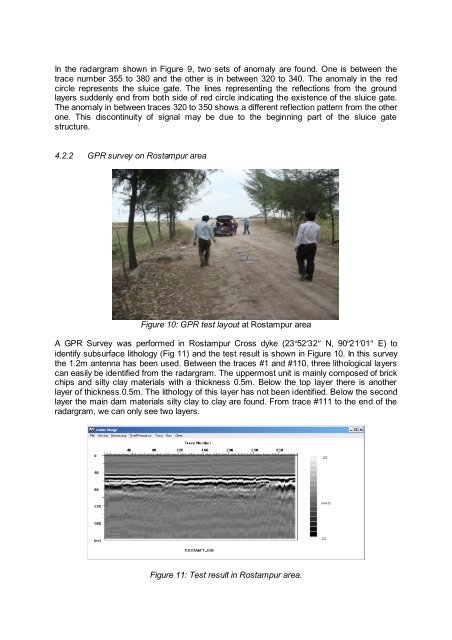GPR for river dyke - GSB
GPR for river dyke - GSB
GPR for river dyke - GSB
You also want an ePaper? Increase the reach of your titles
YUMPU automatically turns print PDFs into web optimized ePapers that Google loves.
In the radargram shown in Figure 9, two sets of anomaly are found. One is between the<br />
trace number 355 to 380 and the other is in between 320 to 340. The anomaly in the red<br />
circle represents the sluice gate. The lines representing the reflections from the ground<br />
layers suddenly end from both side of red circle indicating the existence of the sluice gate.<br />
The anomaly in between traces 320 to 350 shows a different reflection pattern from the other<br />
one. This discontinuity of signal may be due to the beginning part of the sluice gate<br />
structure.<br />
4.2.2 <strong>GPR</strong> survey on Rostampur area<br />
Figure 10: <strong>GPR</strong> test layout at Rostampur area<br />
A <strong>GPR</strong> Survey was per<strong>for</strong>med in Rostampur Cross <strong>dyke</strong> (23º52′32″ N, 90º21′01″ E) to<br />
identify subsurface lithology (Fig 11) and the test result is shown in Figure 10. In this survey<br />
the 1.2m antenna has been used. Between the traces #1 and #110, three lithological layers<br />
can easily be identified from the radargram. The uppermost unit is mainly composed of brick<br />
chips and silty clay materials with a thickness 0.5m. Below the top layer there is another<br />
layer of thickness 0.5m. The lithology of this layer has not been identified. Below the second<br />
layer the main dam materials silty clay to clay are found. From trace #111 to the end of the<br />
radargram, we can only see two layers.<br />
Figure 11: Test result in Rostampur area.


